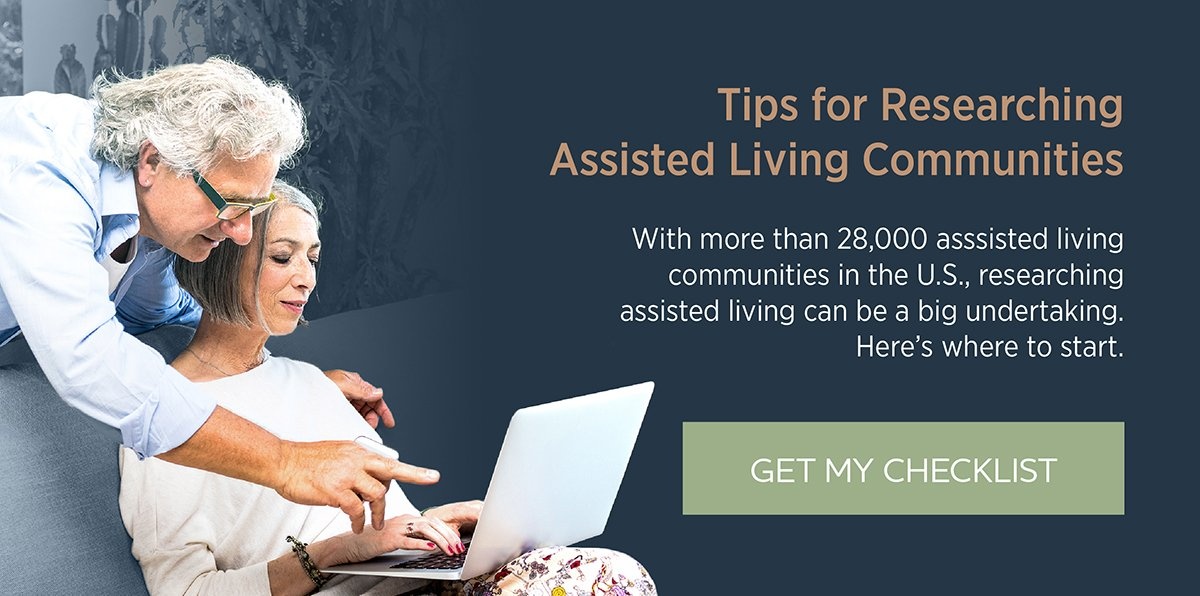
When it comes to choosing an assisted living community, many people wait to move out of their home until it’s too late. Maybe your mom falls or your dad becomes very ill and you are then forced to make the senior living decision very quickly.
Few things in life work out best with a reactive approach.
By researching your options well in advance, before your loved one requires a higher level of nursing care, you can ensure your loved one finds the right assisted living community to meet their needs (AND their preferences). Often, it takes time to find a community that suits your loved one’s lifestyle and personal needs while also supporting them financially or by caregiving.
Whether your loved one is approaching their golden years or smack dab in the middle of them, it’s important to take time to research and tour assisted living communities.
Here are six things to consider when researching assisted living.
1. Be Clear on What Assisted Living Really Is
Many people have preconceived thoughts about what an assisted living community is. It’s easy to assume assisted living communities are the same as your grandma’s nursing home. You might feel guilty even thinking about researching assisted living. Won’t your parent lose their independence if they’re not living at home anymore?
Here’s what you need to know about assisted living: People most often gain independence after they move to assisted living. Unlike a nursing home, which is primarily a medical care facility, assisted living is primarily housing with the ability to select care options that meet their needs.
The most common services provided offered:
- Housekeeping
- Meals
- Laundry
- Transportation services
- Social and wellness programs and activities
- Medication management
- Assistance with using the bathroom, dressing, and grooming
It seems counterintuitive, but many people find that they have more freedom in assisted living to enjoy their hobbies and interests than they did living at home-especially those who are limited in transportation options, or worried that their medical diagnosis will disrupt their ability to participate. There’s no worry about household responsibilities like fixing a leaky sink or mowing the lawn.
2. Search for Communities, Not Facilities
No one wants to put their loved one in a “facility.” The word alone sounds cold and institutional. However, there are some medical-model assisted living facilities that more closely resemble nursing homes so what you research will determine what kind of communities appear in your search.
Narrow your Google search by using “assisted living communities.” Social-model assisted living communities typically resemble apartment complexes.
In many cases, the word “community” is much more descriptive of what assisted living can offer and will allow you to find communities who focus on quality recreational programs, flexible dining options, and holistic health care in addition to providing medical services as needed.
3. Understand the Different Types of Assisted Living Licenses
Most people don’t know that there can be different types of assisted living licenses, which impacts what types of services an assisted living community is allowed to provide. The last thing you want is for your loved one to move twice, so it’s important to know everything from the get-go.
Licenses vary from state to state and many states have a tiered system of licensing. Not all assisted living communities invest in programming or training that exceeds the state minimum requirements. That means that one community might only be licensed to provide light personal care while a community down the street with a higher degree of licensing can provide for those who need help eating or have cognitive impairment or memory loss.
In Montana, for example, Highgate has the Category A, B, and C licenses, which means the communities can help people who are completely dependent on care providers and team members for more than four activities of daily living, which is similar to the type of care one would receive in a nursing home.
However, there are many communities that only have A licensing, so they’re not able to help people with higher level care needs. Additionally, not all assisted living communities offer a memory care program.
That’s why it’s important to think about what your loved one might need in a year or two, if and how a community can meet those needs, and what it could cost.
4. Look at Google Reviews
Once you find a few communities you’d like to know more about, check Google for reviews that can tell you what current and previous residents and families have to say about the community.
Of course, you want to see lots of positive reviews. You’ll also probably come across some negative reviews, too. People tend to gripe a lot online, and there are some people who will just never be happy. Don’t let the negative reviews throw you, but do be sure to look at how the community responds to those negative reviews. More often than not, you will learn the most about a community from how they address negative reviews that are posted.
5. Don’t Forget About Facebook
Look up the Facebook page for each community that interests you, also. Read the comments, but remember, these are not verified sources. Read as many as you can, and see if any pattern develops in what reviewers are saying. If many of them mention the same high or low points, make note of it and be sure to ask on your tour.
In addition to looking at reviews, look at the assisted living community’s photos. See what you can learn about the community’s lifestyle, residents, activities, programs, and even the quality of the dining.
6. Try a Respite Stay
A respite stay is a great option if your loved one wants to try out an assisted living community without committing quite yet. Many assisted living communities offer the option for a stay overnight, for a few days, weeks, or months.
Short-term respite stay residents live in fully furnished suites, and typically enjoy three meals a day, housekeeping and laundry services, personalized care, and medication assistance- however this can vary from community to community. Another benefit of a respite stay is the access to many of the amenities and programs available to full-time residents.
A short-term respite stay can provide the time you need to vet possible long-term options while giving your loved one the opportunity to try out a community prior to a permanent move.
Researching assisted living can be a big undertaking, but with the right support, information, and knowledge of how families find the best assisted living communities, you can make a decision you and your loved one are confident in.
For more tips, download our checklist, How to Research Assisted Living Communities.





